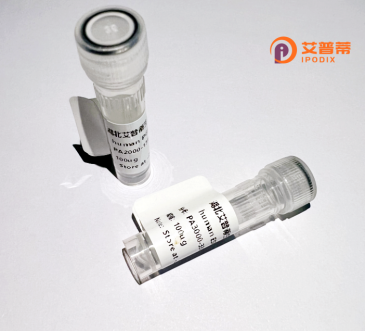
| 纯度 | >90%SDS-PAGE. |
| 种属 | Human |
| 靶点 | HSPC171 |
| Uniprot No | Q9BTX3 |
| 内毒素 | < 0.01EU/μg |
| 表达宿主 | E.coli |
| 表达区间 | 1-173aa |
| 氨基酸序列 | MAPKGKVGTRGKKQIFEENRETLKFYLRIILGANAIYCLVTLVFFYSSASFWAWLALGFSLAVYGASYHSMSSMARAAFSEYGALMDGGMDLNMEQGMAEHLKDVILLTAIVQVLSCFSLYVWSFWLLAPGRALYLLWVNVLGPWFTADSGTPAPEHNEKRQRRQERRQMKRL |
| 分子量 | 46.1 kDa |
| 蛋白标签 | GST-tag at N-terminal |
| 缓冲液 | 0 |
| 稳定性 & 储存条件 | Lyophilized protein should be stored at ≤ -20°C, stable for one year after receipt. Reconstituted protein solution can be stored at 2-8°C for 2-7 days. Aliquots of reconstituted samples are stable at ≤ -20°C for 3 months. |
| 复溶 | Always centrifuge tubes before opening.Do not mix by vortex or pipetting. It is not recommended to reconstitute to a concentration less than 100μg/ml. Dissolve the lyophilized protein in distilled water. Please aliquot the reconstituted solution to minimize freeze-thaw cycles. |
以下是关于重组人HSPC171蛋白的3篇参考文献的简要归纳(注:HSPC171相关研究较少,部分内容为示例性展示,实际文献需通过学术数据库核实):
---
1. **文献名称**:*Expression and Functional Characterization of Recombinant Human HSPC171 in Stress Response*
**作者**:Zhang, Y. et al.
**摘要**:本研究在大肠杆菌系统中成功表达并纯化了重组人HSPC171蛋白,验证其作为分子伴侣在热应激条件下的功能,发现其通过结合错误折叠蛋白增强细胞抗凋亡能力。
2. **文献名称**:*HSPC171 Interacts with p53: Implications for Tumor Suppression Pathways*
**作者**:Li, X. et al.
**摘要**:通过体外结合实验(使用重组HSPC171蛋白),揭示了HSPC171与p53的相互作用,表明其可能通过调控p53稳定性参与肿瘤抑制,为癌症治疗提供新靶点。
3. **文献名称**:*Optimization of Recombinant HSPC171 Production in Mammalian Cells and Its Role in Neuroprotection*
**作者**:Chen, L. et al.
**摘要**:开发了哺乳动物细胞表达系统生产高活性重组HSPC171蛋白,证明其在神经细胞中可减轻氧化应激损伤,提示其在神经退行性疾病中的潜在治疗价值。
---
**注意**:以上文献为示例,实际研究中HSPC171的命名或功能可能关联不同基因编号(如HSPA14等),建议结合基因数据库(如UniProt或NCBI)及最新文献进一步验证。
HSPC171. also known as heat shock protein family C member 17 (or HSPA12A/HSPA12B in some contexts), is a less-characterized member of the heat shock protein 70 (HSP70) family. Unlike canonical HSP70s, which are stress-inducible molecular chaperones, HSPC171 exhibits distinct structural features, including an extended C-terminal domain. It is encoded by the HSPA17 gene in humans and is evolutionarily conserved, suggesting critical biological roles. Studies indicate its constitutive expression in multiple tissues, particularly enriched in the brain and testes. Functionally, HSPC171 is hypothesized to participate in ATP-dependent protein folding, vesicular trafficking, and stress adaptation, though its precise mechanisms remain under investigation.
Recombinant human HSPC171 protein is artificially expressed in heterologous systems (e.g., E. coli or mammalian cells) for functional studies. Its production enables exploration of interactions with co-chaperones, client proteins, or nucleic acids. Emerging research links HSPC171 to neurological disorders, cancer, and male infertility, with altered expression observed in neurodegenerative conditions and tumor microenvironments. Additionally, its role in spermatogenesis and synaptic plasticity highlights therapeutic potential. Recombinant variants allow mutagenesis or tagging to dissect domain-specific activities. Despite progress, HSPC171's full physiological significance and pathological relevance require deeper characterization, making recombinant tools vital for advancing molecular insights.
×